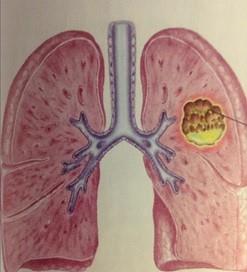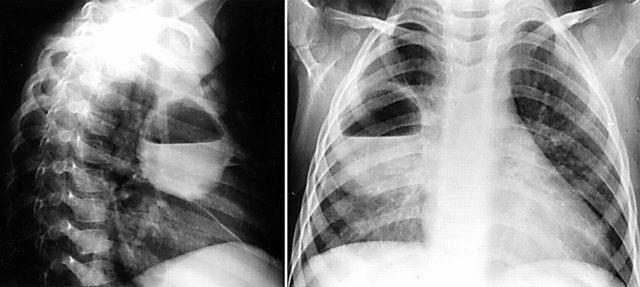Lung abscess: Basic knowledge you need to know

A lung abscess is an infection in the lungs. This is a disease that has existed since a very long time in human history. The symptoms and treatment of the disease were first described by Hippocrates (circa 460-375 BC). Before the antibiotic era, one-third of lung abscess patients died, one-third recovered, and the remainder progressed to a chronic form, empyema, or bronchiectasis. At that time surgery was considered the only effective treatment. Over time, antibiotics gradually replaced that role. This article provides you with a basic understanding of this disease. Includes symptoms, dangers, treatment, and prevention.
content
- 1. What is a lung abscess?
- 2. What can lead to disease?
- 3. What are the symptoms of the disease?
- 4. Complications of the disease
- 5. How is the disease diagnosed?
- 7. Current methods of disease treatment
- 8. How to prevent lung abscess?
1. What is a lung abscess?
A lung abscess is a necrosis of the lung parenchyma caused by a bacterial infection. Most are common bacteria, in addition are tuberculosis bacteria, fungi, and parasites. At that time, in the lungs will form a cavity containing pus, which is necrotic tissue and fluid, surrounded by inflamed lung tissue. Normally bacteria from the mouth or throat are inhaled into the lungs and cause illness.

The lung parenchyma is necrotic, forming a cavity containing pus
2. What can lead to disease?
Several risk factors can lead to a lung abscess, including:
- Loss of cough reflex: common in people who are anesthetized, people with neurological diseases, alcoholics, taking sedatives...
- Oral hygiene is not as good as periodontitis.
- General immunodeficiency such as HIV/AIDS, diabetes, organ transplantation, prolonged use of corticosteroids, etc.
- Airway obstruction due to tumor or foreign body. Then secretions will stagnate behind the blockage, creating conditions for bacteria to grow.
- Infection elsewhere: bacteria or blood clots from another site of infection travel to the lungs to cause an infection. This cause is less common.
Therefore, people with periodontal disease, epilepsy, difficulty swallowing and alcoholics are at high risk for the disease.
3. What are the symptoms of the disease?
The symptoms of a lung abscess are quite similar to pneumonia but last longer. A rather prominent symptom is coughing up phlegm. Sputum may contain blood or pus, with a foul odor. Some other common symptoms are:
- Bad breath
- Fever
- Chest pain
- Shortness of breath
- Sweating at night
- Weight loss
- Tired
- Anorexia
4. Complications of the disease
If left untreated, the mortality rate is about 15-20%. The abscess can rupture and then cause complications such as:
- Emphysema: is the accumulation of a large amount of infectious fluid around the lungs. This is a life-threatening condition and requires immediate intervention to drain the pus.
- Bronchopleural fistula: is the formation of a passageway between the bronchi and the pleura, the cavity surrounding the lungs. Endoscopy or surgery is needed to heal.
- Bleeding from the lungs or chest wall: the amount of blood can be so little or so much that it is life-threatening.
- Infection elsewhere: The infection can spread from the lungs to form new abscesses elsewhere in the body, including the brain.
5. How is the disease diagnosed?
The doctor will first ask about the patient and examine the symptoms. In particular, the history of surgery requiring anesthesia is the first concern.
Blood tests show an increased white blood cell count, indicative of an infection.
If a lung abscess is thought to be, a sample of sputum or pus will be taken for testing.
Diagnostic imaging tools are also used, usually X-rays and CT scans. They help identify the site of infection in the lungs. It also helps doctors rule out other causes like cancer or emphysema.
Another useful means is bronchoscopy. That is, the doctor uses a small tube with a light and camera on the end. A sample of sputum or lung tissue is then removed. This vehicle is used when antibiotic therapy is not working, airway obstruction is suspected, or the immune system is compromised.
In general, lung abscesses are not contagious. The disease is caused mainly by bacteria inhaled from the mouth or throat, so people at high risk of infection can develop the disease. Whereas normal people have a cough reflex and the protective mechanisms of the respiratory tract should easily eliminate this risk.

Cave of abscesses on lateral and straight chest radiographs
7. Current methods of disease treatment
- Antibiotics: are the most common treatment today. Antibiotics are given into the patient's body through a vein for about 3-8 weeks. It can then be replaced with oral medication. Treatment is continued until symptoms are relieved and x-rays are taken to clear the lesion.
- Antifungal, anti-tuberculosis: in rarer cases if these agents are suspected.
- Drainage: when the abscess is larger than 6cm in diameter. With the help of a CT scan, the doctor places a tube into the lung to drain the fluid out.
- Surgery: increasingly rarely used. Then, in very severe cases, part or all of the lung will be removed. In addition, the foreign body in the airway is also an indication of surgery to remove.
8. How to prevent lung abscess?
- Maintain oral hygiene, especially pay attention to periodontitis, need to have regular dental check-ups.
- Thoroughly treat respiratory infections, especially in the nose and throat.
- Do not abuse alcohol.
- For people at high risk of inhaling secretions or food from the mouth-throat, the head of the bed should be raised 30° higher.
- When there are suspicious symptoms related to lung abscess, especially in high-risk people, it is necessary to go to medical facilities for examination and tests.
Today the rate of lung abscess is basically decreasing. The prognosis of the disease is also quite good. Of which, 90% of patients were cured with antibiotics alone and left no sequelae. However, the disease also has life-threatening complications. Prognosis is worse in high-risk individuals. Especially immunocompromised, obstructive bronchial cancer or infection acquired during hospital stay. Some reports even suggest a mortality rate of up to two-thirds in such cases. Therefore, prevention is very important. When in doubt, see a doctor for treatment as soon as possible.
Doctor: Nguyen Le Vu Hoang
See more related articles: